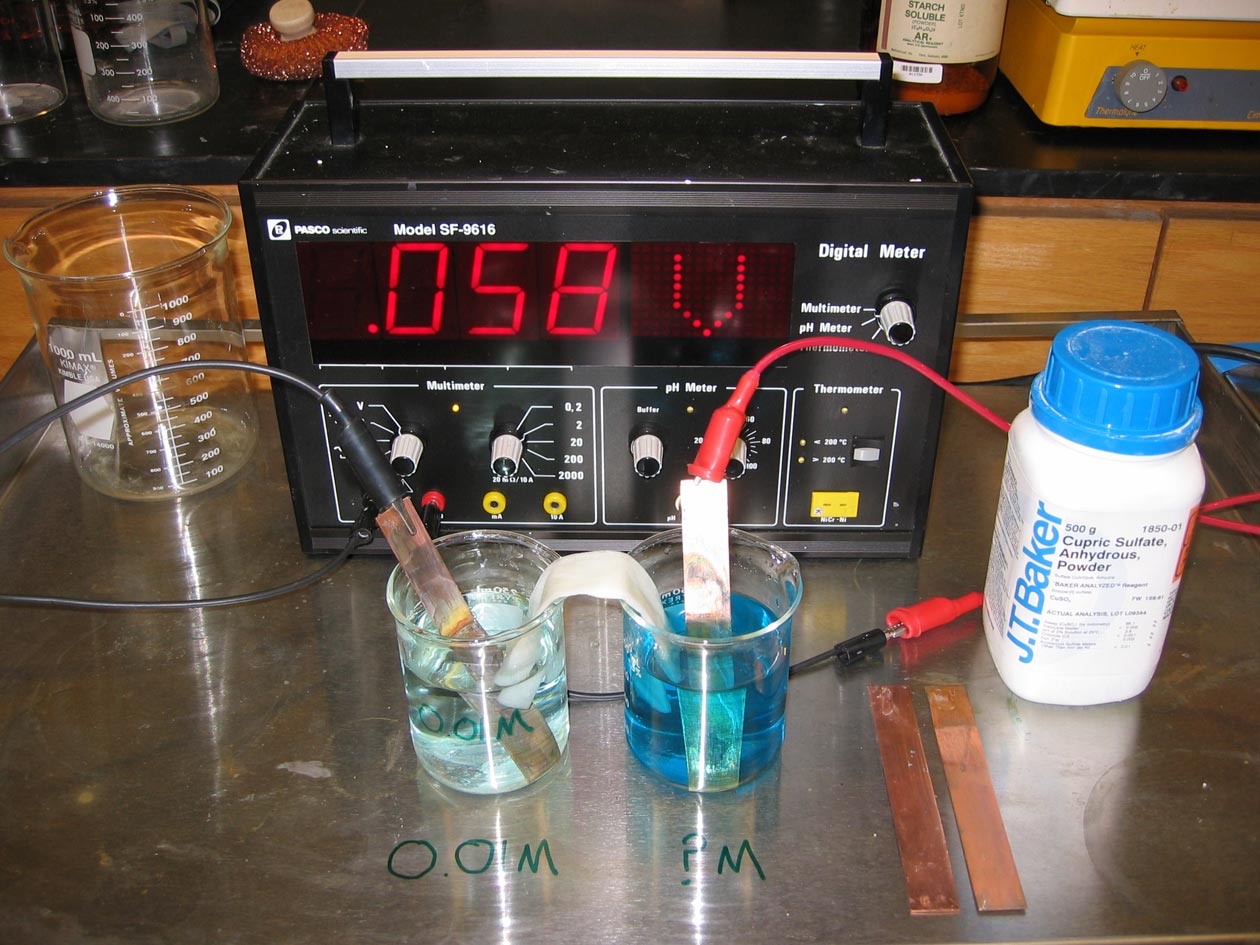Exploring the voltage dependence of a galvanic "concentration cell"
 An electrochemical cell constructed with the same half-reactions at the cathode and anode creates a non-zero voltage, when the concentrations of reactants and products differ.
An electrochemical cell constructed with the same half-reactions at the cathode and anode creates a non-zero voltage, when the concentrations of reactants and products differ.
Ingredients: copper sulfate, copper bar, voltmeter, ammonium nitrate
Procedure: A complete recipe follows.
1. Prepare 1.0M, 0.1M, 0.01M and 0.001M aqueous solutions of copper sulfate.
2. Soak filter paper in ammonium nitrate solution to act as ``salt bridge."
3. Immerse copper electrode in copper sulfate solutions, one solution forming the cathode and one solution forming the anode.
5. Add salt bridge between two solutions.
6. Connect voltmeter across the half-cells and measure voltage.
7. Repeat measurements for various combinations of solution concentrations.
Understanding: We have observed that electrochemical reactions occur in a spontaneous manner, moving towards an equilibrium where the concentrations of reactants and products reflect the difference in the free energy of products and reactants measured at standard state, ΔGo = -nFEo, where
K = 10nEo/0.0592V (at 25C)
When the electrochemical half-cells are chemically distinct, the position of the equilibrium reflects the differences in enthalpy, ΔHo, and entropy, ΔSo, of the reactant and product states through ΔGo = ΔHo - TΔSo = -nF Eo.What happens when the electrochemical cell is constructed from two half-cells, each with the same chemistry. For example, we might have the electrochemical cell Cu(s)|Cu2+(aq)||Cu2+(aq)|Cu(s) where the total reaction is
Cu(s) + Cu2+(aq)[1.0M] → Cu2+(aq)[1.0M] + Cu(s)
Using the standard reduction potentials for the copper and zinc half cells, we findEoCu|Cu2+||Cu2+|Cu = EoCu2+|Cu - EoCu2+|Cu = 0.34V - 0.34V = 0.0V
The measure of the driving force of this reaction is the change in Gibbs free energyΔGoCu|Cu2+||Cu2+|Cu = -n F EoCu|Cu2+||Cu2+|Cu = 0
The fact that EoCu2+|Cu = 0 so that ΔGoCu|Cu2+||Cu2+|Cu = 0 indicates that the reaction will proceed from the standard state conditions of 1.0M solutions and go... no where! It follows that
K = 10nEo/0.0592V = 1 (at 25C)
The driving force in the concentration cell is to make the concentrations in each half-cell equal. When the concentrations of copper ion in each half-cells are equal, the system is at equilibrium. At the point of equilibrium, there is no driving force in the reaction, the voltage is zero, and there is no net flow of electrons.What if the concentrations of copper ions in the two half-cell are different? There will be a driving force to make the concentrations of copper ions in the two half-cells equal. That driving force will be reflected in (1) a Gibbs free energy difference, ΔG, that is not equal to zero, and (2) a measurable, non-zero cell voltage, E = -ΔG/nF.
To predict the value of the cell voltage as a function of the concentrations in the half-cells, we need to introduce a special notation to keep track of the two half-cells. That is, we need to know what is on the left and what is on the right. We can start with the balanced equation
Cu(s) + Cu2+(aq)[right] → Cu2+(aq)[left] + Cu(s)
We know that EoCu|Cu2+||Cu2+|Cu=0, n=2, and Q=[Cu2+]L/[Cu2+]R. The cell voltage at 25C will be given by the Nernst equationECu|Cu2+||Cu2+|Cu = EoCu|Cu2+||Cu2+|Cu - (0.0592V/n) log10 Q
which becomesECu|Cu2+||Cu2+|Cu = - 0.0296V log10 [Cu2+]L/[Cu2+]R
When the concentration of copper ion in the right half-cell exceeds that in the left half-cell, Q < 1, the cell voltage E > 0, and ΔG < 0. The reaction will proceed spontaneously from left to right to increase the concentration of copper ion in the right half-cell. Conversely, if the initial concentration of copper ion in the left half-cell is greater, the reaction will proceed spontaneously in reverse to increase the concentration of copper ion in the right half cell.The chemistry of concentration cells is a beautiful application of Le Chaltelier's Principle. The measurement of the cell voltage gives us a tangible measure, in volts, of the driving force to reduce the stress on the system and return the system to equilibrium.
Predicting concentration cell voltages
Question: Determine the cell voltage, E, for the copper concentration cell, explored in our demonstration at 25C, for the following concentrations.
[Cu2+]R [Cu2+]L
1.0M 1.0M
0.1M 1.0M
0.01M 1.0M
0.1M 0.1M
0.1M 0.001M
You can check your answers here.
The cell voltage is measured to be 0.058V. What is the concentration of copper ion in the solution of unknown concentration?
You can check your answers here.
Using concentration cells to determine unknown solution concentrations
Question:
A concentration cell (pictured above) was created from a 0.01M solution of copper sulfate, and a solution of copper sulfate of unknown concentration. From the color of the solution, it appears that the concentration of copper ion is greater in the solution of unknown concentration.